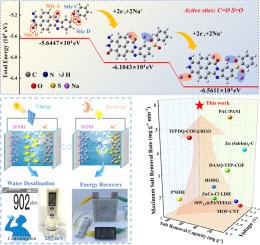纳米片结构氧化还原聚合物实现高效电化学脱盐,用于可持续和通用的水处理
IF 12.4
1区 环境科学与生态学
Q1 ENGINEERING, ENVIRONMENTAL
引用次数: 0
摘要
混合电容去离子(HCDI)是一种很有前途的海水淡化技术,但其发展受到缺乏具有丰富氧化还原活性位点和强大结构稳定性的高性能有机电极的阻碍。为了解决这一挑战,我们通过分子工程设计了一种新型的二维π共轭聚合物(SFPBI),将多个氧化还原活性基团与芳香增强策略集成在一起。综合电化学分析、原位光谱表征和理论计算表明,富含C=N和C=O官能团的SFPBI聚合物能够有效吸附假电容离子。其刚性骨架和广泛的电子离域,以窄的HOMO-LUMO间隙(2.99 eV)为特征,确保了优异的结构稳定性和电化学活性。采用SFPBI电极的HCDI装置具有79.43 mg g - 1的显著脱盐能力,2.65 mg g - 1 min - 1的快速平均去除率,以及出色的再生稳定性(500次循环保留率~ 92.01%),优于已有的有机电极。作为概念验证,我们开发了一个集成的太阳能海水淡化系统,该系统使用相互连接的HCDI设备,不仅生产出符合人类消费标准的淡化水,而且有效地去除有机染料并回收能源。该研究展示了HCDI有机电极设计的突破,为海水淡化和净化提供了可扩展和节能的解决方案。本文章由计算机程序翻译,如有差异,请以英文原文为准。


High-efficiency electrochemical desalination enabled by nanosheet-structured redox polymer for sustainable and versatile water treatment
Hybrid capacitive deionization (HCDI) has emerged as a promising desalination technology, but its development is hindered by the lack of high-performance organic electrodes with abundant redox-active sites and robust structural stability. To address this challenge, we design a novel two-dimensional π-conjugated polymer (SFPBI) through molecular engineering, integrating multiple redox-active moieties with aromatic reinforcement strategies. Comprehensive electrochemical analysis, supported by in-situ spectroscopic characterization and theoretical calculations, reveals that SFPBI polymer, enriched with C=N and C=O functional groups, enables efficient pseudocapacitive ion adsorption. Its rigid backbone and extensive electron delocalization, characterized by a narrow HOMO-LUMO gap (2.99 eV), ensure exceptional structural stability and electrochemical activity. A HCDI device incorporating the SFPBI electrode achieves a remarkable salt removal capacity of 79.43 mg g−1, a rapid average removal rate of 2.65 mg g−1 min−1, and excellent regeneration stability (∼92.01 % retention over 500 cycles), outperforming reported organic electrodes. As a proof of concept, we develop an integrated solar-powered desalination system using interconnected HCDI devices, which not only produces desalinated water meeting human consumption standards but also efficiently removes organic dyes and recovers energy. This study demonstrates a breakthrough in organic electrode design for HCDI, offering a scalable and energy-efficient solution for water desalination and purification.
求助全文
通过发布文献求助,成功后即可免费获取论文全文。
去求助
来源期刊

Water Research
环境科学-工程:环境
CiteScore
20.80
自引率
9.40%
发文量
1307
审稿时长
38 days
期刊介绍:
Water Research, along with its open access companion journal Water Research X, serves as a platform for publishing original research papers covering various aspects of the science and technology related to the anthropogenic water cycle, water quality, and its management worldwide. The audience targeted by the journal comprises biologists, chemical engineers, chemists, civil engineers, environmental engineers, limnologists, and microbiologists. The scope of the journal include:
•Treatment processes for water and wastewaters (municipal, agricultural, industrial, and on-site treatment), including resource recovery and residuals management;
•Urban hydrology including sewer systems, stormwater management, and green infrastructure;
•Drinking water treatment and distribution;
•Potable and non-potable water reuse;
•Sanitation, public health, and risk assessment;
•Anaerobic digestion, solid and hazardous waste management, including source characterization and the effects and control of leachates and gaseous emissions;
•Contaminants (chemical, microbial, anthropogenic particles such as nanoparticles or microplastics) and related water quality sensing, monitoring, fate, and assessment;
•Anthropogenic impacts on inland, tidal, coastal and urban waters, focusing on surface and ground waters, and point and non-point sources of pollution;
•Environmental restoration, linked to surface water, groundwater and groundwater remediation;
•Analysis of the interfaces between sediments and water, and between water and atmosphere, focusing specifically on anthropogenic impacts;
•Mathematical modelling, systems analysis, machine learning, and beneficial use of big data related to the anthropogenic water cycle;
•Socio-economic, policy, and regulations studies.
 求助内容:
求助内容: 应助结果提醒方式:
应助结果提醒方式:


